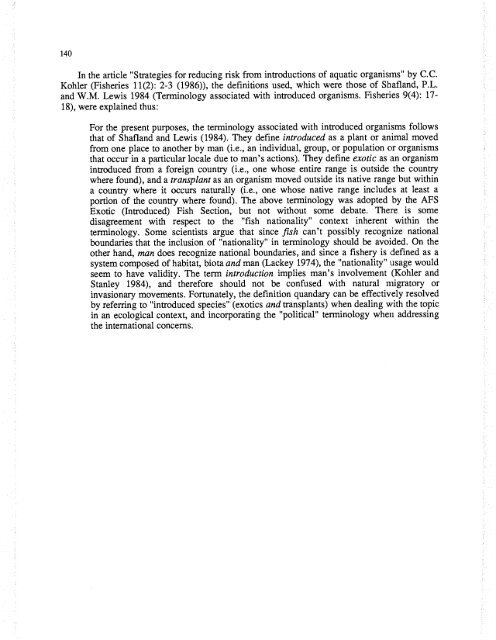Exotic Aquatic Organisms - International Development Research ...
Exotic Aquatic Organisms - International Development Research ...
Exotic Aquatic Organisms - International Development Research ...
Create successful ePaper yourself
Turn your PDF publications into a flip-book with our unique Google optimized e-Paper software.
140<br />
In the article "Strategies for reducing risk from introductions of aquatic organisms" by C.C.<br />
Kohler (Fisheries 11(2): 2-3 (1986)), the definitions used, which were those of Shafland, P.L.<br />
and W.M. Lewis 1984 (Terminology associated with introduced organisms. Fisheries 9(4): 17-<br />
18), were explained thus:<br />
For the present purposes, the terminology associated with introduced organisms follows<br />
that of Shafland and Lewis (1984). They define introduced as a plant or animal moved<br />
from one place to another by man (i.e., an individual, group, or population cr organisms<br />
that occur in a particular locale due to man's actions). They define exotic as an organism<br />
introduced from a foreign country (i.e., one whose entire range is outside the country<br />
where found), and a transplant as an organism moved outside its native range but within<br />
a country where it occurs naturally (i.e., one whose native range includes at least a<br />
portion of the country where found). The above terminology was adopted by the AFS<br />
<strong>Exotic</strong> (Introduced) Fish Section, but not without some debate. There is some<br />
disagreement with respect to the "fish nationality" context inherent within the<br />
terminology. Some scientists argue that since fish can't possibly recognize national<br />
boundaries that the inclusion of "nationality" in terminology should be avoided. On the<br />
other hand, man does recognize national boundaries, and since a fishery is defined as a<br />
system composed of habitat, biota and man (Lackey 1974), the "nationality" usage would<br />
seem to have validity. The term introduction implies man's involvement (Kohier and<br />
Stanley 1984), and therefore should not be confused with natural migratory or<br />
invasionary movements. Fortunately, the definition quandary can be effectively resolved<br />
by referring to "introduced species" (exotics and transplants) when dealing with the topic<br />
in an ecological context, and incorporating the "political" terminology when addressing<br />
the international concerns.

















